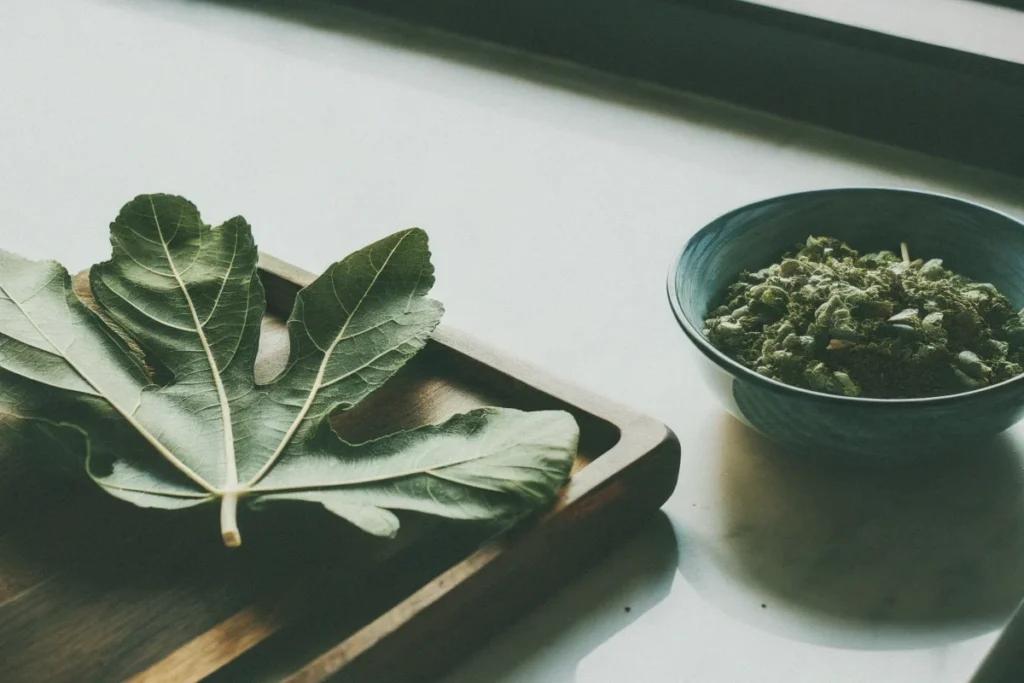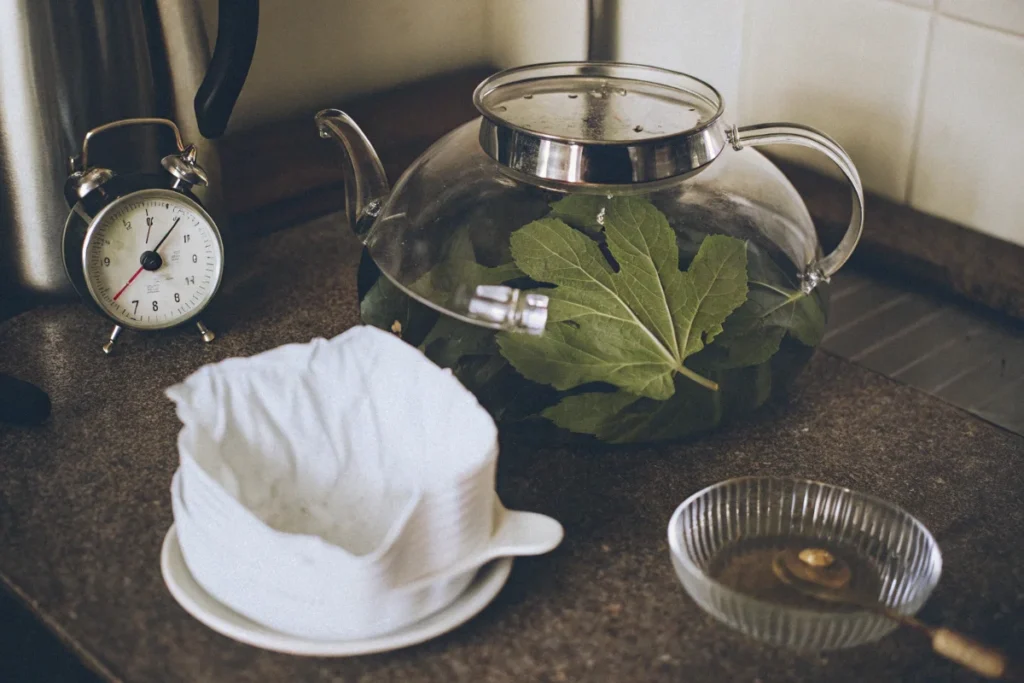Fig leaf tea has gained widespread attention in recent years for its unique flavor and impressive health benefits. This fragrant brew, derived from the leaves of the fig tree (Ficus carica), offers a refreshing change from more traditional herbal infusions. Moreover, it provides nutrients that may support various aspects of health and wellness. Therefore, if you’re looking to expand your tea collection or simply want to discover a fresh, herbal beverage, fig leaf tea might be your next favorite. In this comprehensive guide, we will explore the origins, nutritional benefits, potential health advantages, and practical tips for preparing fig leaf tea.
Fig trees have been cultivated for centuries in the Mediterranean region, the Middle East, and parts of Asia. Historically, figs were prized as both food and medicinal resources. However, their leaves often remained in the shadow of the more popular fig fruit. Recently, people have begun to examine these leaves for their hidden potential, and fig leaf tea has emerged as a hidden gem. Some cultures have used fig leaf brews for centuries to address various ailments. Yet, it is only now gaining popularity in the mainstream wellness world.
In this article, we’ll delve into different aspects of fig leaf tea. You’ll learn about its potential nutritional profile, how it may support specific health concerns, and the best ways to prepare a cup of this soothing drink. We’ll also address common questions and possible concerns related to its consumption. Furthermore, you’ll discover how to enhance its flavor by blending fig leaf tea with other herbs. By the end, you’ll have a clear idea of why fig leaf tea is worth considering in your daily routine.
Above all, quality matters. Choosing fresh or properly dried fig leaves can make a significant difference in both taste and benefits. For example, the leaves should be vibrant and free of mold or discoloration. When these standards are met, each sip of fig leaf tea delivers a delightful, mildly sweet aroma with hints of coconut or green tea. Therefore, adding this infusion to your daily regimen could be a smart move. Let’s explore the full story of fig leaf tea, starting with the core reasons why you might prefer it over other herbal infusions.
Why Choose Fig Leaf Tea Over Other Herbal Infusions?
Fig leaf tea stands out among the many herbal teas available in today’s market. While popular varieties like chamomile, peppermint, and green tea have their strengths, fig leaf tea can offer a distinct advantage. First, its flavor profile is unique. It has a gentle sweetness that is reminiscent of coconut or roasted nuts. This delightful taste often surprises first-time drinkers.
Moreover, fig leaf tea is refreshing without the bitterness that can sometimes accompany other herbal blends. This pleasant aspect might encourage consistent consumption. Therefore, if you’ve been searching for a mild and enticing beverage, fig leaf tea could be the one.
Fig Leaf Tea vs. Green Tea
Green tea is popular for its antioxidants, yet fig leaf tea holds its own in the world of health-supportive drinks. Both teas contain plant-based compounds that may assist cellular function, but fig leaf tea has an entirely different nutrient set. Furthermore, it comes without the caffeine present in green tea, making it a soothing option for late-evening enjoyment.
Fig Leaf Tea vs. Chamomile
Chamomile is known for its calming effects, but it doesn’t match fig leaf tea’s mildly sweet and nutty taste. Although chamomile and fig leaf tea can both provide relaxation, fig leaf tea offers a unique flavor profile with potential nutritional bonuses.
Key Takeaways
- Unique Taste: Fig leaf tea has a gently sweet flavor with nutty undertones.
- No Caffeine: It’s a relaxing option at any time of day, without the stimulating effects of caffeine.
- Possible Nutritional Advantages: Many enthusiasts believe fig leaf tea provides vitamins and minerals that support overall health.
By choosing fig leaf tea over other herbal infusions, you gain an opportunity to savor a distinctive taste while exploring a range of potential benefits. However, taste is only one part of the puzzle. Next, we will uncover the nutritional aspects that make this tea worthy of attention.

Nutritional Profile of Fig Leaf Tea
Fig leaf tea is intriguing not only for its flavor but also for its potential nutritional value. While formal nutritional databases often focus on the fig fruit, ongoing research suggests that fig leaves may provide a unique array of beneficial substances.
Vitamins and Minerals
Fig leaves likely contain small amounts of vitamins such as vitamin A, vitamin C, and some B vitamins. These nutrients are crucial for energy metabolism, immune support, and maintaining healthy skin. However, the exact concentrations in fig leaf tea can vary depending on how the tea is brewed and the freshness of the leaves.
Moreover, you might find trace minerals like potassium, magnesium, and calcium. Potassium, for instance, plays a vital role in muscle function and fluid balance. Meanwhile, magnesium supports nerve health and helps regulate blood pressure. Although the amounts may be modest, every little bit adds up when combined with a balanced diet.
Antioxidant Compounds
In addition to vitamins and minerals, fig leaves contain antioxidant compounds. These natural plant chemicals help protect cells from oxidative stress. Oxidative stress occurs when harmful molecules, known as free radicals, outnumber protective antioxidants in the body. Antioxidants in this infusion may support healthy aging and cellular function.
Fiber-Like Qualities
Although the tea itself doesn’t contain large amounts of dietary fiber, the components extracted during steeping can have fiber-like qualities. For example, certain compounds may aid in promoting healthy digestion. However, these effects can vary depending on individual responses and steeping methods.
Key Points to Consider
- Varied Nutrients: Fig leaf tea may offer trace amounts of vitamins, minerals, and antioxidants.
- Potential Digestive Support: Some compounds in fig leaves might support digestion.
- Lifestyle Integration: Drinking this infusion can serve as an easy addition to a nutrient-conscious lifestyle.
Since consistent consumption matters, brewing a cup of fig leaf tea daily may complement your existing healthy habits. Next, let’s take a closer look at some potential health benefits that enthusiasts often associate with fig leaf tea.
Potential Health Benefits of Fig Leaf Tea
Fig leaf tea is more than just a tasty beverage. Some individuals believe that it can promote balanced blood sugar levels and help in managing various body systems. While research is still evolving, there are several promising avenues worth exploring. Remember that any herbal remedy should complement, not replace, medical advice.
Support for Blood Sugar Management
Several studies suggest that compounds in fig leaves could impact glucose metabolism. Therefore, many people who struggle with maintaining healthy blood sugar consider fig leaf tea as an additional tool. Moreover, pairing fig leaf tea with a balanced diet and regular exercise may yield the best results.
Aid for Skin and Hair
Fig leaf tea enthusiasts often report improvements in skin and hair health. This might be due to vitamins, antioxidants, and trace minerals present in the leaves. For example, antioxidants support collagen integrity, while vitamins A and C can help protect the skin from oxidative damage.
Possibility for Digestive Comfort
Because fig leaves contain natural plant compounds, a warm cup of this infusion might soothe the gastrointestinal tract. Some individuals drink it to ease bloating or occasional discomfort. However, more research is needed to confirm these benefits conclusively. Nevertheless, many herbalists recommend fig leaf tea for gentle digestive support.
Boost for Overall Wellness
When combined with a healthy diet, fig leaf tea may serve as a mild yet consistent wellness booster. It provides hydration, a comforting ritual, and a range of phytochemicals. Furthermore, the act of preparing tea can be a mindful practice, potentially promoting relaxation and stress relief.

How to Prepare Fig Leaf Tea at Home
Making fig leaf tea at home is straightforward. You can either use fresh leaves directly from a fig tree or purchase dried fig leaves from a reputable supplier. Whichever option you choose, ensure the leaves are pesticide-free and free of mold.
- Gather Leaves
- Fresh: Rinse them thoroughly to remove dust and potential contaminants.
- Dried: Check for any signs of moisture or mold in the packaging.
- Boil Water
- Bring fresh, filtered water to a gentle boil.
- Avoid reboiling water multiple times, as it can affect the taste.
- Steep Properly
- Tear or crush the leaves slightly to release their oils.
- Place them in a teapot or infuser.
- Pour hot water over the leaves and cover.
- Steep for 5–10 minutes for a stronger flavor.
- Strain and Enjoy
- Remove the leaves.
- Let the tea cool slightly before sipping.
- Add honey or a few drops of lemon juice if desired.
Brewing Tips
- Experiment with Steeping Times: A shorter steep yields a lighter flavor, while a longer steep intensifies it.
- Combine with Other Herbs: Fig leaf tea pairs well with mint, lemon balm, or even a pinch of cinnamon.
- Avoid Over-Boiling: Prolonged boiling can lead to bitterness or loss of nuanced flavors.
By following these steps, you can create a delightful cup of this infusion that suits your taste preferences. However, this tea also lends itself to creative variations. Next, we’ll explore ways to blend fig leaf tea with other herbs for unique flavor profiles.
Common Variations: Combining Fig Leaf Tea with Other Herbs
Fig leaf tea offers a smooth, slightly sweet flavor that can be enhanced when paired with complementary herbs or spices. Blending different ingredients can yield personalized brews suitable for any mood or occasion.
Fig Leaf Tea with Mint
Mint’s cooling sensation creates a refreshing contrast to the warmth of fig leaf tea. Therefore, this combination is ideal for a hot summer day. Additionally, mint leaves may help soothe digestion, adding another layer of potential health benefits.
Fig Leaf Tea with Lemon Grass
Lemon grass brings a zesty, citrusy brightness to fig leaf tea. This duo is perfect for morning or mid-afternoon sipping, as the uplifting scent of lemon grass provides an energizing boost without caffeine.
Fig Leaf Tea with Chamomile
If you crave extra relaxation, chamomile can complement the mild sweetness of this infusion. Moreover, chamomile’s delicate floral aroma pairs well with the nutty undertones of fig leaves. This blend can be particularly soothing in the evening.
Fig Leaf Tea with Cinnamon or Ginger
Spices like cinnamon and ginger add warmth and depth to fig leaf tea. For example, a sprinkle of cinnamon can accentuate the nutty notes, while ginger provides a spicy kick. These mixes can be especially comforting during cooler months.
Additional Pairing Tips
- Sample Small Batches: Blend a small amount first to find your perfect flavor balance.
- Adjust Sweetness Naturally: Use natural sweeteners like honey or stevia if needed.
- Consider Temperature: Serve iced for a refreshing summer drink, or keep it hot for a cozy winter beverage.
By experimenting with such variations, you’ll likely discover a go-to blend that satisfies both your palate and wellness goals. Yet, while this infusion can be a positive addition to many diets, it’s crucial to understand possible cautions and side effects. Let’s discuss those next.
Cautions and Considerations
Although fig leaf tea is generally well-tolerated, it’s important to exercise caution in certain situations. Herbal teas can have powerful effects, and individual responses may vary. Therefore, consulting a qualified healthcare professional is always advisable before adding any new tea or supplement to your routine.
Potential Allergies
Some individuals may be allergic to certain compounds in fig leaves. If you experience skin irritation, swelling, or digestive discomfort after consuming fig leaf tea, discontinue use and seek medical advice.
Skin Photosensitivity
Fig leaves contain compounds that might increase the skin’s sensitivity to sunlight. Therefore, if you handle fresh fig leaves, always wash your hands thoroughly. Avoid prolonged sun exposure afterward, or use gloves and protective clothing during harvesting. Although this risk is typically lower when using dried leaves for tea, it’s still wise to be aware.
Interactions with Medications
If you take medications to manage blood sugar or blood pressure, monitor your levels closely when introducing this infusion. Although such interactions are not universally established, it’s better to be safe. Moreover, consult your healthcare provider if you have any concerns about possible interactions.
Pregnancy and Breastfeeding
Research on fig leaf tea’s safety for pregnant and breastfeeding individuals is limited. Therefore, it’s prudent to consult a healthcare professional before consuming it during these life stages.
Incorporating Fig Leaf Tea into Your Daily Routine
Integrating fig leaf tea into your wellness plan doesn’t have to be complicated. Simple adjustments can make it a natural part of your daily life. Moreover, the variety of flavors and preparation methods ensures you won’t grow bored quickly.
Morning Ritual
Start your day with a soothing cup of warm fig leaf tea. Doing so can help you stay hydrated and gently awaken your senses without caffeine. Add a slice of lemon or a drop of honey for extra zing.
Midday Break
Replace your usual coffee or sugary beverage with a cup of iced fig leaf tea. You’ll enjoy its mild sweetness and avoid the caffeine crash. Therefore, you can stay focused and energized throughout the afternoon.
Evening Wind-Down
The infusion can be a calming addition to your evening routine. For an especially relaxing effect, try blending it with chamomile. This combination helps you shift from daytime bustle to nighttime tranquility. By consciously choosing a caffeine-free beverage, you support better sleep quality.
Meal Pairings
Serve fig leaf tea alongside light meals or snacks. For example, it pairs well with salads, fruit plates, or simple sandwiches. This strategy not only helps you stay hydrated but also complements subtle flavors in your dishes.
On-the-Go Options
Brew a batch of this infusion in advance and store it in a thermos for easy access. Whether you’re heading to work or running errands, having a container of fig leaf tea on hand can help you maintain healthy habits away from home.
FAQ
Below are some common questions people ask, along with detailed answers to help you make informed decisions.
What is fig leaves tea good for?
Fig leaves tea, or fig leaf tea, is often praised for its potential to support blood sugar balance, digestive comfort, and skin health. It contains vitamins, minerals, and antioxidants that may offer various wellness benefits. Some people drink this infusion to help maintain healthy glucose levels, while others enjoy its soothing qualities for the digestive system.
Who should not drink fig leaf tea?
Individuals with known allergies to figs or latex should exercise caution, as fig leaves may contain similar compounds. People taking medications for diabetes or blood pressure should consult a healthcare provider before trying fig leaf tea, due to possible interactions. Additionally, pregnant and breastfeeding individuals should seek medical advice, as research on safety in these groups is limited.
Can I make tea from fresh fig leaves?
Yes, you can make tea using fresh fig leaves from a pesticide-free tree. Wash the leaves thoroughly to remove dirt or contaminants. Tear or crush them, then steep in hot water for 5–10 minutes. However, be mindful of potential skin irritation from direct contact with fresh fig leaves.
How many cups of fig leaf tea per day?
Most people find 1–3 cups of fig leaf tea per day to be enjoyable and beneficial. However, listen to your body and watch for any adverse reactions. It’s always best to start with one cup to see how you tolerate it. If you have underlying health conditions or are on medication, consult a healthcare professional for personalized guidance.

